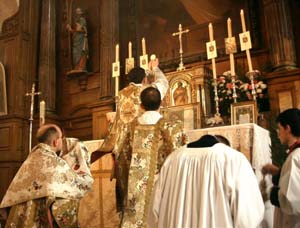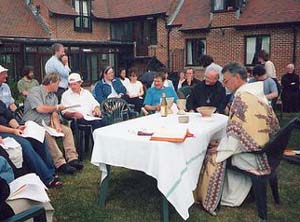 |
Consequences of Vatican II
Desacrificing the Mass - Part II
How Vatican II Abolished
the Sacrificial Character of the Mass
Fr. Stephen F. Somerville
It is very good for us to know and ponder this truth of Sacrifice in the Mass at any time in our Catholic life. But it is painfully necessary to ponder the Mass Sacrifice in this present time, because some 40 years ago, in 1969, the Vatican authorities in Rome published a new, “reformed” order or ritual for celebrating the Mass. We call it the Novus Ordo, the new order. It developed from the Second Vatican Council, which had concluded just four years before 1969. We know it well today as the established English Mass (or in other languages) in all our parishes. We also know that Protestants do not believe the Mass or Holy Eucharist or Communion Service to be a Sacrifice. For them, Mount Calvary on Good Friday was the one and only Christian sacrifice.

Above, The renewal of the Sacrifice of Calvary in the Tridentine Mass; below, a Protestantized meal in a Novus Ordo Mass, Wales
 |
We also need to know that ecumenism was a major concern of Vatican II, that is, a policy of striving for Christian Unity among the many, divided Protestant and schismatic denominations. It is a fact that ecumenism greatly influenced the shape of the New Catholic Mass. To put it another way, our Catholic Mass has been considerably protestantized, to make it more user-friendly to Protestants. Several Protestant authorities have stated that the new order of Catholic Mass could now be used in good conscience by protestant ministers. This is a shocking admission. It means that the Catholic doctrines disbelieved by Protestants have been removed or watered down excessively. One of these Catholic truths is that the Mass is a real sacrifice offered by a real priest. This was declared solemnly by the 1545 Catholic Council of Trent.
In this light, you will be asking yourself, what of all those clear indications in the old Catholic Mass that it really is indeed a Sacrifice? What of all those prayers we were detailing, that say sacrifice so plainly? What of all those lines, such as "I will go unto the altar of God" at the start of Mass, until the end of Mass when the priest says, "May my sacrifice be acceptable to thee, Lord, and be a propitiation to win thy mercy"? Are not all these lines a standing declaration that the Mass is indeed a sacrifice?
I must now tell you the tragic news. Every one of those positive sacrifice lines in the Mass has been removed by the reform ... All are gone! The new Catholic Mass is stripped of all those signs of true Sacrifice. The few that remain are less clear, more vague. For example, sacrifice could now mean a mere sacrifice of praise, that is, good words of worship addressed to God. Real presence, another key word, if said of Christ, could now mean only his spiritual presence, and not the bodily, fleshly presence that we must believe in at Mass. You may remind me that the Roman Canon is not abolished, and its many positive sacrifice words are still there, still available. Yes, true, but they are almost never used. Most priests read one of the new, short and protestant-friendly Eucharistic prayers.
There is more bad news. All the holy signs of the Cross made by the priest over the offerings are now removed, except for one. All the many reverent genuflections of the priest to the Sacred Species on the altar have been stopped by the new rubrics, except for one each at the two-fold consecration. The altar of stone, for sacrifice, has been largely replaced by a table of wood, for a mere meal. The priest, formerly facing God at Mass, the Divine Father to whom all honor and glory is due, now turns his back on God to face the people, as a kind of chairman, or banquet presider, or master of ceremonies. He looks less and less like a priest. Formerly speaking in Latin, and mostly in silence, out of reverence for the sacred mystery he was conducting, the priest now speaks in English or French or other modern language, as for any earthly meeting or transaction. Communion once received kneeling and on the tongue with reverence, is now received standing and in the hand.
Summing up, I declare to you that the Novus Ordo Catholic reformed Mass is a sad scene of devastation and impoverishment, even if some priests still try to perform it reverently. Remember that rule: Lex orandi, lex credendi. The way we pray sets the way we believe. Catholics who pray at the New Mass will almost certainly weaken, if not lose, their Faith. Already, surveys tell us that only 30 percent of adult Catholics still believe in the Real Presence of Christ's Body and Blood. This alone makes a real sacrifice impossible. We seem to be in that great apostasy predicted by St. Paul (II Thess 2).
Dear fellow faithful, let us continue steadfast in the Catholic Mass of all time. Let us pray loyally for all right-believing Catholics, especially those who are persecuted. Let us keep reading and studying, according to our ability and duty, to understand Catholic truth and tradition better and better.
I close with a short prayer of the priest at the offertory:
"In a humble spirit and a contrite heart, may we be received by Thee, O Lord; and let our sacrifice be so made in thy sight this day, that it may please Thee, 0 Lord God."

Posted April 10, 2007

Related Topics of Interest
 Desacrificing the Mass - Part I Desacrificing the Mass - Part I
 New Mass in Latin - Comments on Sacramentum caritatis New Mass in Latin - Comments on Sacramentum caritatis
 Better ICEL, Better Hope? Better ICEL, Better Hope?
 The Bugnini Liturgy and the Reform of the Reform The Bugnini Liturgy and the Reform of the Reform
 The Catholic Revolution: New Wine, Old Wineskins and Vatican II The Catholic Revolution: New Wine, Old Wineskins and Vatican II
 Is the Catholic Crisis Really Explained? Is the Catholic Crisis Really Explained?
 The Canonization of Wojtyla - the Moral Free Pope The Canonization of Wojtyla - the Moral Free Pope
 On Resisting the Novelties of the Conciliar Church On Resisting the Novelties of the Conciliar Church
 The New Mass: A Flavor of Protestantism The New Mass: A Flavor of Protestantism
 The Bad Effects of the Papal Apologies The Bad Effects of the Papal Apologies

Related Works of Interest
|
|
Vatican II | Hot Topics | Home | Books | CDs | Search | Contact Us | Donate

© 2002-
Tradition in Action, Inc. All Rights Reserved
|
 |
|